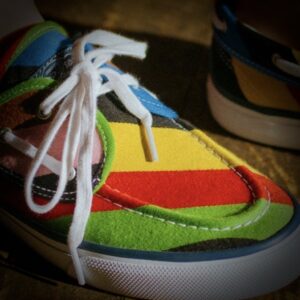Early on in my Tarot journey, I ran across a video of author Vincent Pitisci’s lecture at the Theosophical Society, presenting his thoughts on what makes the Tarot such a powerful tool for problem-solving and developing one’s intuition. He describes the similarities between a card reading and the creative techniques used in R&D and strategic planning by organizations around the globe.
The way Pitisci uses the cards takes advantage of the way our minds naturally work. In a process called “conceptual blending” our minds look to make connections, to make sense, between two seemingly unrelated phenomena.
Here’s the full lecture. It’s well worth the watch.
Dog’s Paw to Deck Shoe?
 My favorite example of how this works is the Sperry Topsider deck shoe. The soles of the shoes have a unique pattern of very fine squiggly lines cut into them. The story behind them is that their inventor noticed his dog being able to stop himself instantly from sliding on wet ice. At first, he thought that the animal was somehow driving a claw into the ice, but there was no evidence of that on the ice patch.
My favorite example of how this works is the Sperry Topsider deck shoe. The soles of the shoes have a unique pattern of very fine squiggly lines cut into them. The story behind them is that their inventor noticed his dog being able to stop himself instantly from sliding on wet ice. At first, he thought that the animal was somehow driving a claw into the ice, but there was no evidence of that on the ice patch.
As he examined the pads of his dog’s paw, he noticed a small pattern of wrinkles, and realized that these must have been what provided purchase on the slippery surface. He used a razor to replicate the pattern on a piece of a rubber tire, and it demonstrated excellent grip on a wet deck. The shoes were a hit.
I have no idea whether or not this particular story is based in actual fact, but it’s a good illustration of what Pitisci speaks about. If you were to be designing a boat shoe, it would be unlikely that you would think “I wonder if my dog’s paw can help?” Yet, sometimes a random (or in this example, happenstance) stimulus provides helpful information. Our minds make powerful associations that we might not go looking for if we were to proceed in a more linear way.
Application to Tarot
The power, or “genius” of the Tarot as Pitisci calls it, is in the randomness of the draw. We have a question in mind, or a set of ideas in the shape of a card spread. We shuffle, we cut and we draw, and this introduces a random stimulus in response to the question or ideas. Our mind naturally looks for associations or connections between the positions and the cards, and begins to create a story.
The history and lore of the Tarot is part of what makes it such a delight, but one need not have an interest in any of that to make good use of the cards. You don’t even really need a grasp of the traditional meanings of the cards, although I think this probably helps bring another layer of meaning to the operation.
All you really need is your mind, a puzzling question, a compelling set of images, and their random juxtaposition.
It truly is genius.